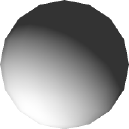TAPESTRY: The Art of Representation and Abstraction
Shading Overview
What's it all about?
Shading is the generic term used to describe the complex process of deciding what intensity, color, or shade should be used on the screen to represent each specific part of the object or scene being rendered.Shading algorithms take into account the scene's geometry and lighting, surface and light attributes, and program control parameters, in order to establish the appropriate color.
Shading Equation
Taken together, the different considerations establish an equation for the calculating the surface color. In rough terms, this equation usually takes this form-
color intensity = ambient term + shading term + highlight term
Ambient Term
This term in the equation acknowledges that some light bounces around in the environment enough to become "omnidirectional" or "adirectional" (without direction). It simply arrives, in equal quantities, at all surfaces. Normally this term contributes only a small amount to the overall color, or intensity result.Shading Term
 This term contributes the most to the color intensity calculation for the surface. The simplest approach (flat shading) calculates a single illumination value for each surface in the model. However, more subtle calculations (smooth shading) can be used where the actual geometry is itself an approximation of a curved surface. For example, the ball at the right has exactly the same geometry as the one above, but is rendered differently. You can see this along the edges, or profile of the geometry..
This term contributes the most to the color intensity calculation for the surface. The simplest approach (flat shading) calculates a single illumination value for each surface in the model. However, more subtle calculations (smooth shading) can be used where the actual geometry is itself an approximation of a curved surface. For example, the ball at the right has exactly the same geometry as the one above, but is rendered differently. You can see this along the edges, or profile of the geometry..
Highlight Term
This term provides the effect of "glancing" light, or highlights, on object surfaces. It depends mostly on the relationship between the viewer, the surface, and the light source(s).Last updated: April, 2014
